
By Meagan Cordeiro Lutz
I am currently the teacher-librarian at two elementary schools in Surrey School District. Three days of my week I am at Janice Churchill Elementary. Two years ago, we received a district grant to physically transform the library space at Janice Churchill into a library learning commons. There is flexibility in the space with our new modular seating and movable tables at different heights. Students helped pick the colours and move stuff around often. The space was designed with purpose for many combinations of people and learning goals. The staff are collaborative and kind. I am so happy to work in this space and have a part in the learning that happens there and throughout the school. I feel grateful to have been able to work and grow in my role there for the past three years. After completing a redesign of the physical space, I have been focusing in on collection development. This has led to the inclusion of sensory and audiobooks to meet the needs of our students.

Creating Location Responsive Collections
I have been a teacher-librarian at five schools during my seven years in this role. Even though all five schools have been in the same school district, none of them have been the same. I have done my best to create collaboration opportunities that met the needs of specific teachers at each location and develop collections that prioritized the reading interests of the students that learn there. The most popular book in one LLC might not be quite the draw at the next. I have always wanted students to be able to walk in to find a book and see that they are part of the space when they see the books they have helped select. Just when I was getting to know one student population, I was assigned to a new one. I needed a way to collect and organize data quickly from new groups of students. One of my first attempts was to generate wordles based on students’ responses to the simple question “what do you like to read?”. It proved to be a quick and effective way to get a snapshot of a class or grade-group and make sure those books are available. Student and teacher requests are always my number one order generator. Throughout the year my biggest challenge is to make sure I organize all my hastily scribbled post-it notes into an organized word doc, but these wordles give me a place to start. Looking back on it I see that there is room for more nuance here and that through this method I will miss out on some quieter voices that have really great book ideas. Even a second attempt to display this for the class and ask them, “what’s missing that we need in the library?” response could allow more students to be included in shaping book selection. This was just a starting point.

Library Learning Commons
During my first years in the teacher-librarian role, I completed my Masters of Literacy Education. The Resource-Based Teaching course that I completed at the beginning was the most applicable to library ordering and helped me think about supporting the curriculum with purchasing. Soon after that I had the opportunity to work on two teacher inquiry projects in two consecutive years. These gave me time to develop learning goals and narrow in with the support of colleagues. During a BCTF Teacher Inquiry Project, 11 teachers from our school had release time to compose and answer an inquiry question. The teachers at my school developed questions focused on self-regulation and to connect with that I wanted to think about self-identity. I focused on student identity in the library and had the time to collect more data from my school and get to know the readers better. This was done through online forms and selective interview follow-ups. From this information I learned that there were a lot of students that connected with clumsy, funny and dorky characters, some students that didn’t connect with any characters and others that wanted to see more languages represented in our books. With this data in hand I focused on finding more diverse books. The following year I joined a group of teacher-librarians led by our district Helping Teacher as we considered our practice and goals while using the Leading Learning document to guide us. This allowed another opportunity to focus in on our collection development. I decided to focus in on Designing for Accessibility in the LLC. Specifically, I wanted to consider how our students with special needs are being encouraged to read for enjoyment in the library.
Students with Special Needs and LLC Access
The issue about both methods of data collection that I had completed so far at this school (the wordles and online forms) is that they require students to be in the LLCs. Transitions can be difficult times for students and with a busy schedule of book exchanges, library preps and collab I don’t have a lot of time to check in with classroom teachers as their class comes and goes. If a student doesn’t show up at the door, I might quietly assume they are absent that day or completing work in class. I started asking who isn’t coming to the library and who is not accessing our collection? The follow-up questions were why and how can our collection support them? When I started asking these questions, I learned that some students were not coming to the library because they were using that time to go to the sensory room for a break. The students who were taking breaks in the sensory room during their library block were not coming to borrow books at other times. They were not borrowing books from the school. I wondered how we could bring the sensory into the LLC.
Sensory Collection

googly eyes, craft feathers and straws.
I started collecting sensory books and placing them in a defined and prominent spot next to our display of new books for all our students to see, feel and borrow. The sensory collection began as a set of print books that incorporated touch and we soon added sound. My criteria for sensory book selection was that there must be interactive tactile features or textured illustrations throughout the book and there must be a narrative text. It was important, and yet unexpectedly difficult, to meet my second criteria. I wanted to make sure these books were engaging for students and families to share together. These books became wildly popular and this bin often sat empty. I had specific students in mind when ordering these books, but I encouraged anyone interested to borrow them. Students I hadn’t imagined picking them up were thrilled. They wondered aloud about what the tiger’s bushy tail was made of or whether this textured feeling was right for an alligator. They seemed so joyful as they interacted with these books. They wondered what materials they had at home to make their own sensory book. All the excitement was wonderful, but I knew I was on the right track when one of our Education Assistants stopped me in the hallway to tell me the family of her student said they were so happy to have something sent home from library that fit their child’s needs and allowed their child to be active during reading time together. They asked the EA to thank me. Instead of spending too long being down on myself for not making this connection sooner I made sure they had a new one next week and that I kept looking for more books that met my criteria. We soon began adding books that incorporated sound to this collection as well at students’ request.

Audiobook Collection
Around the same time, I started ordering audiobooks to supplement our most popular chapter books. There are other places to find audiobooks including on our district catalogue and public library, but the simplicity of the PlayAways that you just need to plug headphones in, and press play was perfect for our elementary aged students. I had heard these wondrous things talked about at a BCTLA Conference the year before but wasn’t immediately sure that they could fit in the budget. I had a conversation with one of our Education Assistants that made me want to order some to test out whether they would be a good fit. She mentioned that she didn’t know if the books going home were being read because the student she worked with couldn’t read independently and someone might not always be available to read with them. This student is comprehending at the same level as their peers and wants to read the same books as their peers. I ordered 6 of the most popular books for our intermediate students in this audiobook format that travels in what looks like a DVD case and lasts for 12 hours of listening on one AAA battery. As soon as they arrived, they were in backpacks and they didn’t hit the shelves for the rest of the year. Again, the interest spread way further than one student. Many intermediates wouldn’t be able to enjoy the book that their peers are enjoying because they were not reading at that level. This was their way in and to make that connection. Someone asked if it was okay to take the print home with the audio, so they could follow along. “Great! Absolutely!” I replied. That initial student that we wanted to order these for now has options that they can read at home independently and we are ordering more to keep up with the demand. After that first audiobook went home that student’s family was asking what audiobook they would bring home next.
Benefits for All Students
I hope what was clear when I outlined our selection of sensory and audiobook titles is how many students benefitted from their inclusion in our collection. The main goal of finding these materials was to support students with special needs find materials that support reading for enjoyment. What happened when we included sensory books was that it opened a playful exploration of how we interact with story. What happened when we included audiobooks was that it broke down barriers for students enjoying the same books as their peers. I want to make this connection not because our main goal wasn’t worthwhile. It is absolutely something that needed to be addressed in order to include all our learners. I highlight this in case you do have a sensory book or two hidden in a cupboard somewhere. Making them accessible for all created awareness around the different ways stories are shared, started so many interesting conversations about the input of information and allowed students with special needs to experience these materials designed for them next to the enthusiasm of their classmates. Having done that has opened new ways into learning for other students and began normalizing accessing information in different ways with a more inclusive collection.

Meagan Cordeiro Lutz has been a teacher-librarian for the last seven years after teaching in the K-2 classroom. She completed a Masters of Literacy Education from the University of British Columbia. Meagan’s interests include learning commons design, inclusive collections and multimodal storytelling including through video games. You can find her tweeting about learning and books @MsMCordeiro.